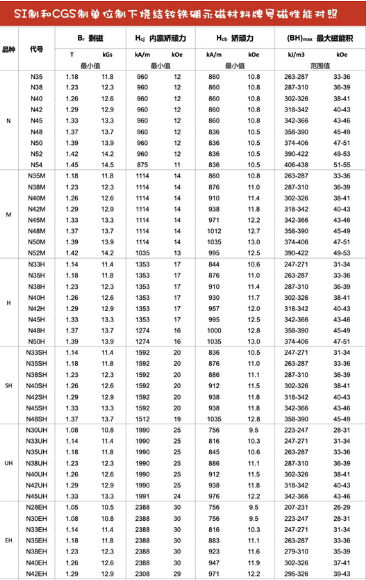NdFeB magnet grades are the ones that people in the magnet-related industries come into contact with every day, so
-What is behind these complicated grades?
-What are the differences between different grades of NdFeB magnets?
-How to choose the right NdFeB magnets through the grades?
Sintered NdFeB magnet performance parameters, you can see a wide range of products, evaluation of performance indicators are also a variety of white people look at may be directly blindfolded, how are still all in English it? Then let's talk about the doorway here.
First of all, the common sintered NdFeB grade can be divided into seven categories: N, M, H, SH, UH, EH and TH. In addition to the N category, each of the other types will appear in the end of the product number, for example, N38M is the M series, N38TH is the TH series, and if it is the “N38” no letter behind, that he is N! series. (Of course, there are some uncommon and higher performance grades, you can learn about them by yourself if you are interested, we will only introduce the more common ones today.)
Secondly, there are four main indexes to measure the performance of sintered NdFeB products.
1. Br residual magnetism: unit for Tesla (T) and Gauss (Gs), 1Gs = 0.0001 T. It refers to a magnet in a closed-circuit environment by the external magnetic field magnetization to the technical saturation after the withdrawal of the external magnetic field, at this time the sintered neodymium iron boron magnet performance of the magnetic induction strength. Commonly speaking, it can be temporarily understood as the magnetic force of the magnet after magnetization.
2. Hcb coercivity: the unit is Oster (Oe) or ampere/meter (A/m), 1A/m = (4π/1000) Oe, 1 Oe = (1000/4π) A/m. The value of the reverse magnetic field strength required to reduce the magnetic induction to zero when the magnet is reverse magnetized is known as the magnetic coercivity. However, at this time the magnetization strength of the magnet is not zero, only the added reverse magnetic field and the magnetization strength of the magnet acts to cancel each other, at this time if the withdrawal of the external magnetic field, the magnet still has a certain magnetic properties.
3. Hcj Endowed Coercivity: The strength of the reversed magnetic field that needs to be applied to reduce the magnetization strength of the magnet to zero is called endowed coercivity, and his unit of measurement is the same as that of coercivity. Magnetic grades are categorized according to the magnitude of their endowed coercivity. Low coercivity N, medium coercivity M, high coercivity H, extra high coercivity UH, very high coercivity EH, high coercivity TH. The endowed coercivity of NdFeB magnets decreases as the temperature rises, so when choosing to use NdFeB magnets, be sure to choose the grade that is suitable for our use ~ the next issue of the Magnetic Emperor will be further introduced!
4. (BH)max Maximum magnetic energy product: represents the magnetic energy density established in the space of two magnetic poles of the magnet, i.e. the static magnetic energy per unit volume of the air gap, it is the maximum value of the product of B and H, and its size directly indicates the performance of the magnet. The number in the magnet grade represents the theoretical maximum magnetic energy product of the product.
Again, we can see that each performance indicator has two units of measurement, which is because they use different unit systems - SI and CGS, i.e., the International System of Units and the Gaussian System of Units, which is like the difference between “meters” and “miles” in the unit of length. It is like the difference between “meter” and “mile” in the unit of length. There is a certain conversion relationship between the SI and CGS, but it's complicated, so we won't expand on it.
Finally, it is not difficult to realize that the performance of sintered NdFeB products under each grade is not the only fixed value, but a numerical interval. The performance range of products from different manufacturers is not exactly the same, so you need to pay special attention to the performance of the supplier's products to meet your requirements when shopping. The latest national standard for sintered NdFeB (GB/T 13560-2017) issued by the State Administration of Quality Supervision, Inspection and Quarantine (AQSIQ) and the Standardization Committee, which came into effect in May 2018, stipulates the minimum or interval values of various performance indicators for different grades of products, as shown below for your reference.












